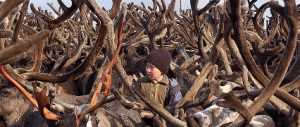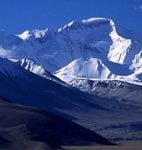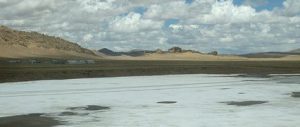The annual monsoon that is the lifeline of south Asia stops at the 5,000-metre slopes of the Pir Panjal range in the Himalayas. The Tibetan plateau effectively starts on the northern slopes of the Lahaul and Spiti valleys in the Indian state of Himachal Pradesh. Little glaciers roll down both the northern and southern slopes, later turning into streams that feed the mighty Indus River system that straddles India and Pakistan.
The trouble is that the glaciers are getting smaller – and so are the streams. “Do you see that glacier coming down the saddle between those two peaks?” asked local farmer Vikas Sharma in late September. “We call it sona pani [gold water], because that is the water that irrigates the farms in my village, Kumpi, which you can see near the bottom of the valley.”
“Until 10 years ago, that glacier used to come right down to the bottom of the slope. For at least nine months of the year, it used to start melting only when it reached the outskirts of our village,” said Sharma. “But then it started to melt higher and higher up the slope, and there was less water too. Now it is September – just after the monsoon, when it should have the maximum ice – but it’s only halfway down the slope. I don’t know how we are going to irrigate our crops next summer.”
His village is not the only one where people risk losing their crops due to shortage of water. Sona pani is part of the complex of glaciers at the Rohtang pass that feed two major rivers: the Beas River, which flows through the Kullu Valley, and the Chenab River, which flows through the Lahaul valley. Once out of the Himalayas and in the great plains of south Asia, these rivers flow into the Indus River and form vital parts of the system that provides water to Punjab (literally, the “land of the five rivers”) in India and Pakistan. Less snow here means less water in the rivers that irrigate the main foodgrain producing areas in both countries.
The Hindu Kush Himalayas – sometimes called the water tower of Asia – provide water to 10 major river basins in China, India, Pakistan, Nepal, Bangladesh, Bhutan, Afghanistan and a number of countries in central Asia. An estimated 1.3 billion people depend on the waters from these glaciers. They are at increasing risk due to climate change, which has caused the glaciers to recede.
I stood in a meadow next to the almost-4,000-metre-high Rohtang Pass, which connects the northern areas of Himachal Pradesh and the Ladakh region of Jammu and Kashmir to the rest of India. The rugged road, much loved by trekkers and motorsports enthusiasts due to its breathtaking views, used to be closed by the snows from November to May each year.
Officially, it still closes throughout this period. “But now we never know when it will snow and when it will not”, said Sukh Ram, one of the men employed by the Indian Army’s Border Roads Organisation to keep the pass clear. “Last winter, it didn’t really snow till February, though we kept the pass closed as per orders. But now it suddenly started snowing a couple of weeks back [in early September]. We had to close the pass for three days, and so many people were stranded on the northern side.”
In the meadow there was snow on the ground, which began to melt as the sunshine gathered strength and fell on the walls of a broken-down shed. “We shelter in that shed when there’s a blizzard,” said Ram. “This is a dangerous place. It gets very windy every afternoon – and you never know when a blizzard will strike. When we came here in May, after a gap of many months, we found the frozen body of a man inside the shed. He was a local bureaucrat, who must have got stuck in a blizzard while trying to cross the pass.”
These dangers have always been part and parcel of life in the Himalayas. But life is getting more perilous, and in new ways. As the glaciers start to melt faster due to global warming, in many cases the waters accumulate just below the glacier, as the little stream that issues from the glacier’s snout becomes unable to carry the extra water. These
threaten to burst their banks as the water accumulates. Such glacial lake outburst floods – GLOFs, as they are called – have occurred a number of times in Nepal and Bhutan over the past 50 years, though there is no record of them before. Every time it means loss of life and property downstream. Scientists at the Kathmandu-based International Centre for Integrated Mountain Development (ICIMOD) say there are at least 36 GLOF threats right now in Nepal alone.
These are the immediate threats as the glaciers recede. In the longer term, the risk is that ice accumulation in these glaciers will occur at a rate slower than the melt, leading to the disappearance of at least the smaller glaciers from the Himalayan region. There are an estimated 9,000 to 12,000 of these small glaciers in the Indian Himalayas alone. Their disappearance, in turn, means rivers that now run throughout the year will become seasonal. The glaciers may contribute only about 10% of the total water flow in large river basins like the Ganges, but this is vital for perennial water flow and for water supply downstream in the dry months, when it is most needed.
Scientists say they do not know enough about what is happening to the Himalayas, especially the Himalayan glaciers, as a result of climate change. The last assessment report of the Intergovernmental Panel on Climate Change, published in 2007, described the area as data-deficient. Indian and Chinese scientists are now starting a large number of research projects to study the effects, including some joint projects. Meanwhile, the few weather stations that have been set up show that the rate of warming in the Himalayas is six times higher than the global average, says professor Syed Iqbal Hasnain, a leading glaciologist at the New Delhi-based The Energy and Resources Institute. India has just started a major research programme to study the Himalayan ecosystem, especially the way it is being affected by climate change. But many worried policy-makers say the time to act is now: they cannot afford to wait for the results of systematic scientific studies, which may take years. As Rajesh Kumar, a glaciologist with the Birla Institute of Technology Extension Centre in Jaipur, points out, even calculating the extent to which the temperature has gone upwill take years, since there were few weather stations in the Himalayas in the past.
Farmer Vikas Sharma had little doubt about the need to act now. “I don’t know to what extent it’s getting warmer,” he said. “We don’t have the sophisticated instruments to measure that exactly. But there’s no doubt it’s getting warmer and winters are getting shorter. We’ll soon have to start growing other varieties of maize that don’t need so much water. We know those varieties are not so good and we won’t get the same price in the market. But what’s the option?”
Joydeep Gupta is associate editor of Indo-Asian News Service and secretary of the Forum of Environmental Journalists of India.
Homepage image by Simply Czar




